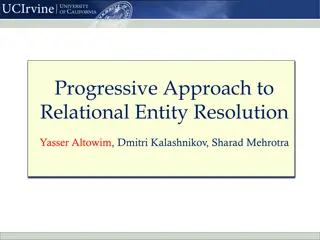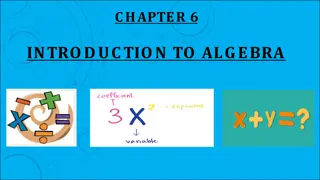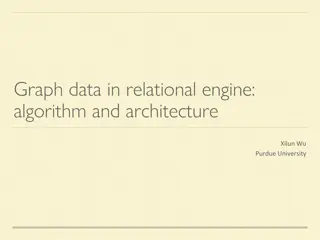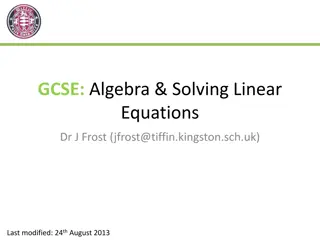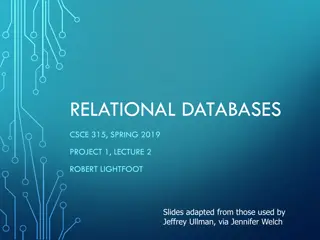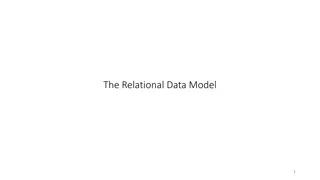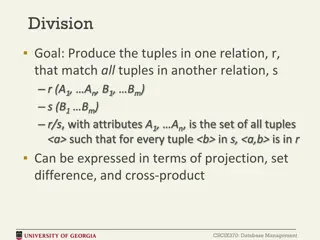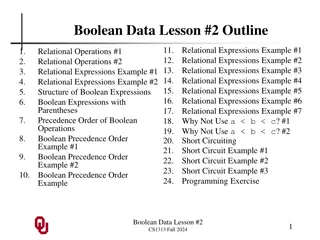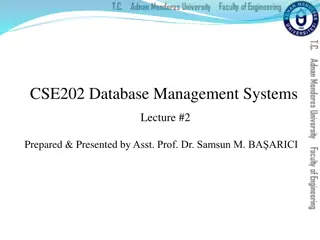
Understanding Relational Algebra in Database Management Systems
Learn about Relational Algebra in DBMS, introduced by Edgar F. Codd in 1970. Discover how it is used to access data from databases by specifying "What to Do" and "How to Do" in queries. Explore basic operations such as Select and Project with examples.
Download Presentation

Please find below an Image/Link to download the presentation.
The content on the website is provided AS IS for your information and personal use only. It may not be sold, licensed, or shared on other websites without obtaining consent from the author. If you encounter any issues during the download, it is possible that the publisher has removed the file from their server.
You are allowed to download the files provided on this website for personal or commercial use, subject to the condition that they are used lawfully. All files are the property of their respective owners.
The content on the website is provided AS IS for your information and personal use only. It may not be sold, licensed, or shared on other websites without obtaining consent from the author.
E N D
Presentation Transcript
What is Relational Algebra in DBMS? Relational Algebra came in 1970 and was given by Edgar F. Codd (Father of DBMS). It is also known as Procedural Query Language(PQL) as in PQL, a programmer/user has to mention two things, "What to Do" and "How to Do". Suppose our data is stored in a database, then relational algebra is used to access the data from the database. The First thing is we have to access the data, this needs to be specified in the query as "What to Do", but we have to also specify the method/procedure in the query that is "How to Do" or how to access the data from the database.
Basic Operations Six fundamental operations are mentioned below. The majority of data retrieval operations are carried out by these. Let's know them one by one. But, before moving into detail, let's have two tables or we can say relations STUDENT(ROLL, EMPLOYEE(EMPLOYEE_NO, NAME, AGE) which will be used in the below examples. NAME, AGE) and
Example STUDENT EMPLOYEE ROLL 1 2 3 4 5 6 NAME Aman Atul Baljeet Harsh Prateek Prateek AGE 20 18 19 20 21 23 EMPLOYE E_NO E-1 E-2 E-3 E-4 E-5 NAME AGE Anant Ashish Baljeet Harsh Pranav 20 23 25 20 22
Select () Select operation is done by Selection Operator which is represented by "sigma"( ). It is used to retrieve tuples(rows) from the table where the given condition is satisfied. It is a unary operator means it requires only one operand. Notation : p(R) Where is used to represent SELECTION R is used to represent RELATION p is the logic formula Let's understand this with an example: Suppose we want the row(s) from STUDENT Relation where "AGE" is 20
AGE=20 (STUDENT) ROLL NAME AGE 1 Aman 20 4 Harsh 20
Project () Project operation is done by Projection Operator which is represented by "pi"( ). It is used to retrieve certain attributes(columns) from the table. It is also known as vertical partitioning as it separates the table vertically. It is also a Notation : Where is used to r is used to a is the Let's understand this Suppose we want the names of all students from STUDENT Relation unary operator. a(r) represent represent attribute with PROJECTION RELATION list an example:
NAME(STUDENT) NAME Aman Atul Baljeet Harsh Prateek As you can see from the above output it eliminates duplicates. For multiple attributes, we can separate them using a ",".
ROLL,NAME(STUDENT) ROLL 1 2 3 4 5 6 NAME Aman Atul Baljeet Harsh Prateek Prateek
Union ( ) Union operation is done by Union Operator which is represented by "union"( ). It is the same as the union operator from set theory, i.e., it selects all tuples from both relations but with the exception that for the union of two relations/tables both relations must have the same set of Attributes. It is a binary operator as it requires two operands.
Notation: R S Where R is the first relation, S is the second relation If relations don't have the same set of attributes, then the union of such relations will result in NULL. Example Suppose we want all the names from STUDENT and EMPLOYEE relation
Example- NAME(STUDENT) NAME(EMPLOYEE) NAME Aman Anant Ashish Atul Baljeet Harsh Pranav Prateek
Set Difference (-) Set Difference as its name indicates is the difference between two relations (R-S). It is denoted by a "Hyphen"(-) and it returns all the tuples(rows) which are in relation R but not in relation S. It is also a binary operator. Notation : R - S Where R is the first relation, S is the second relation Just like union, the set difference also comes with the exception of the same set of attributes in both relations.
Example We would like to know the names of students who are in STUDENT Relation but not in EMPLOYEE Relation. NAME(STUDENT) - NAME(EMPLOYEE) NAME Aman Atul Prateek
Cartesian Product (X) Cartesian product is denoted by the "X" symbol. Let's say we have two relations R and S. Cartesian product will combine every tuple(row) from R with all the tuples from S. I know it sounds complicated, but once we look at an example, you'll see what I mean. Notation: R X S Where R is the first relation,S is the second relation. As we can see from the notation it is also a binary operator.
Example Example- -Combine the two relations STUDENT and EMPLOYEE. STUDENT X EMPLOYEE EMPLOYEE_ NO E-1 E-2 E-3 E-4 E-5 E-1 E-2 E-3 E-4 E-5 ROLL NAME AGE NAME AGE 1 1 1 1 1 2 2 2 2 2 Aman Aman Aman Aman Aman Atul Atul Atul Atul Atul 20 20 20 20 20 18 18 18 18 18 Anant Ashish Baljeet Harsh Pranav Anant Ashish Baljeet Harsh Pranav 20 23 25 20 22 20 23 25 20 22
Rename () In Relational Algebra, the RENAME ( or (R S)) operator is used to change the name of a relation (table) or its attributes (columns). This is particularly useful when dealing with complex queries, self-joins, or avoiding ambiguity in operations. Notation: (R,S) Where R is the new relation name,S is the old relation name.
Syntax of RENAME Operator Syntax of RENAME Operator 1.Renaming a Relation (Table Name Change) S(R) This renames relation R to S. 2. Renaming Attributes (Column Name Change) S(A1,A2,...,An)(R) This renames relation R to S and assigns new names to its attributes.
Example- Renaming a Table Renaming a Table Consider a relation Employee (ID, Name, Salary). If we want to rename Employee to Worker, we use: Worker(Employee) The table is now referenced as Worker instead of Employee.
Example-2 Renaming Column Given Employee (ID, Name, Salary), we rename attributes: Emp(ID,EmpName,EmpSalary)(Employee) The new relation is Emp (ID, EmpName, EmpSalary).
Why Use RENAME in Relational Algebra? Why Use RENAME in Relational Algebra? Avoid conflicts in self-joins (when joining a table with itself). Improve query readability by using meaningful names. Simplify expressions when dealing with multiple relations.
Points Select ( )is used to retrieve tuples(rows) based on certain conditions. Project ( )is used to retrieve attributes(columns) from the relation. Union ( ) is used to retrieve all the tuples from two relations. Set Difference (-) is used to retrieve the tuples which are present in R but not in S(R-S). Cartesian product (X) is used to combine each tuple from the first relation with each tuple from the second relation. Rename ( )is used to rename the output relation.
Derived Operations Derived operations known as extended operations, these operations can be derived from basic operations and hence named Derived Operations. These include three operations: Join Operations, Intersection operations, and Division operations.
Join Operations Join Operation in DBMS are binary operations that allow us to combine two or They are further classified into two types: Inner Join, and Outer Join. First, let's have two relations of E_NO, E_NAME, CITY and EXPERIENCE. EMPLOYEE table contains employee's information such as id, name, city, and experience of employee(In Years). The other relation is DEPARTMENT consisting of D_NO, D_NAME, E_NO and MIN_EXPERIENCE. DEPARTMENT table defines the mapping of an employee to their department. It contains Department Number, Department Name, Employee Id of the employee working in that department, and the minimum experience required(In Years) to be in that department. more relations. EMPLOYEE consisting
Example EMPLOYEE DEPARTMENT E_NO E_NAME CITY EXPERIENCE D_NO D_NAME E_NO MIN_EXPERIENCE E-1 Ram Delhi 04 D-1 HR E-1 03 E-2 Varun Chandigarh 09 D-2 IT E-2 05 E-3 Ravi Noida 03 E-4 Amit Bangalore 07 D-3 Marketing E-3 02
Cartesian Product EXPERIENC E 04 04 04 09 09 09 03 03 03 07 07 07 MIN_EXPERI ENCE 03 05 02 03 05 02 03 05 02 03 05 02 E_NO E_NAME CITY D_NO D_NAME E_NO E-1 E-1 E-1 E-2 E-2 E-2 E-3 E-3 E-3 E-4 E-4 E-4 Ram Ram Ram Varun Varun Varun Ravi Ravi Ravi Amit Amit Amit Delhi Delhi Delhi D-1 D-2 D-3 D-1 D-2 D-3 D-1 D-2 D-3 D-1 D-2 D-3 HR IT E-1 E-2 E-3 E-1 E-2 E-3 E-1 E-2 E-3 E-1 E-2 E-3 Marketing HR IT Marketing HR IT Marketing HR IT Marketing Chandigarh Chandigarh Chandigarh Noida Noida Noida Bangalore Bangalore Bangalore
Inner Join When we perform Inner Join, only those tuples returned that satisfy the certain condition. It is also classified into three types: Theta Join, Equi Join and Natural Join.
Theta Join A Theta Join ( -Join) in relational algebra is a type of join operation where two relations (tables) are combined based on a condition involving a comparison operator ( ). The condition can use operators such as: = (equal to) (not equal to) > (greater than) < (less than) (greater than or equal to) (less than or equal to)
Syntax R S R and S are two relations (tables). (Theta condition) is the condition used to match records from both relations.
Example 1: Theta Join with ">" Condition Example 1: Theta Join with ">" Condition Consider two relations: Employee (EmpID, Name, DeptID, Salary) EmpID 101 102 103 Name Ajay Rahul Ravi DeptID 1 2 1 Salary 50000 60000 70000 Department (DeptID, DeptName, Budget) DeptID DeptName Budget 1 2 HR IT 65000 80000
Theta Join Theta Join with the condition Salary > Budget Salary > Budget Employee Salary>BudgetDepartment EmpID Name DeptID 103 Ravi Salary 70000 DeptName Budget HR 1 65000 Only Ravi (Salary = 70000) from DeptID 1 (HR, Budget = 65000) satisfies the condition Salary > Budget.
Equi Join An Equi Join ( ) is a special case of the Theta Join ( - Join) where the join condition uses only the "=" (equal to) operator. It combines rows from two tables based on matching values in a common attribute. Syntax R R.A=S.BS R and S are two relations (tables). A and B are attributes (columns) in the respective tables that are compared using A = B.
Example Employee Employee.DeptID=Department.DeptIDDepartment Salary 50000 70000 60000 DeptName Budget HR HR IT EmpID Name DeptID 101 Ajay 103 Rahul 1 102 Ravi 1 65000 65000 80000 2 The DeptID column is used to match rows between Employee and Department tables. Only rows with matching DeptID values are included in the result.
Natural Join A Natural Join ( ) is a special type of Equi Join where the common attribute(s) between automatically matched, and duplicate columns are removed from two tables are the result. Note: Preferably Natural Join is performed on the foreign key. Notation : R S R and S are two relations (tables). The join automatically matches attributes with the same name in both tables and removes duplicates.
Example Student Table Course Table StudentI D 1 2 3 CourseID CourseName Credits Name CourseID C101 Data Science 4 Alice Bob Charlie C101 C102 C101 C102 AI & ML 3 C103 Cybersecurity 4 R S StudentID 1 3 2 Name Alice Charlie Bob CourseID C101 C101 C102 CourseName Credits Data Science Data Science AI & ML 4 4 3
Key Differences from Equi Join Natural Join automatically detects common attributes. Removes duplicate columns. If no common attribute exists, it acts as a Cartesian Product (returns all possible row combinations).
Comparison with Other Joins Comparison with Other Joins Duplicate Columns Removed Join Type Condition Used Equi Join Explicitly on A = B No Auto-detects common attributes Any condition (=, >, <, etc.) Natural Join Yes Theta Join No
Outer Join Unlike Inner Join which includes the tuple that satisfies the given condition, Outer Join also includes some/all the tuples which don't satisfy the given condition. It is also of three types: Left Outer Join, Right Outer Join, and Full Outer Join. Let's say we have two relations R and S, then Below is the representation of Left, Right, and Full Outer Joins.
Left Outer Join Returns all tuples from the left relation. If there is a matching tuple in the right relation, it is included. If no match is found, NULL values are used for the missing attributes. Notation : R S
Example Employee Department Dept_ID Dept_Name Emp_ID Name 101 102 103 104 Dept_ID 1 2 3 4 Alice Bob Carol David 1 HR 2 IT 5 Finance E D
Breakdown of the Expression Breakdown of the Expression 1. Perform Inner Join R1=E This returns only the matching tuples. D 2. Find Unmatched Tuples from the Left Table (Employee) R2=E EmpID,Name,DeptID(E D) This extracts employees who have no matching department.
Cont.. 3. Append NULL Values for Unmatched Tuples R3=R2 {NULL} This assigns NULL to missing department attributes 4. Final Result E D=R1 R3 Emp_ID 101 102 103 104 Name Alice Bob Carol David Dept_ID 1 2 3 4 Dept_Name HR IT NULL NULL
Right Outer Join A Right Outer Join ( tuples from the right relation and the matching tuples from the left relation. If no match is found, NULL values are assigned to attributes of the left relation. Notation: E D ) in relational algebra retrieves all
This extracts departments that have no matching employees. Example- 1. Perform Inner Join R1=E This returns only the matching tuples. D 2. Find Unmatched Tuples from the Right Table (Department) R2=D DeptID(E D) This extracts departments that have no matching department.
Cont.. 3. Append NULL Values for Unmatched Tuples R3={NULL,NULL,DeptID} R2 This assigns NULL to missing employee attributes. Final Right Outer Join Result E D=R1 R3 Emp_ID Name Dept_ID Dept_Name 101 Alice 1 HR 102 Bob 2 IT NULL NULL 5 Finance
Full Outer Join A Full Outer Join ( tuples from both relations. If there is a match between tuples, they are combined. If no match is found, NULL values are assigned to the missing attributes from the other relation. ) in relational algebra retrieves all
Cont.. Perform Inner Join R1=E This returns only the matching tuples. D 2. Find Unmatched Tuples from the Left Table (Employee) R2=E EmpID(E D) This extracts employees that have no matching departments.
Cont.. 3. Find Unmatched Tuples from the Right Table (Department). R3=D DeptID(E This extracts departments that have no matching employees. D) 4. Append NULL Values for Unmatched Tuples Assign NULL values for missing Dept_ID attributes in R_2. Assign NULL values for missing Emp_ID attributes in R_3. R4={EmpID,Name,DeptID,NULL} R2 R5={NULL,NULL,DeptID,DeptName} R3

